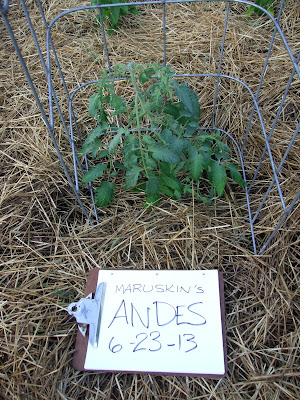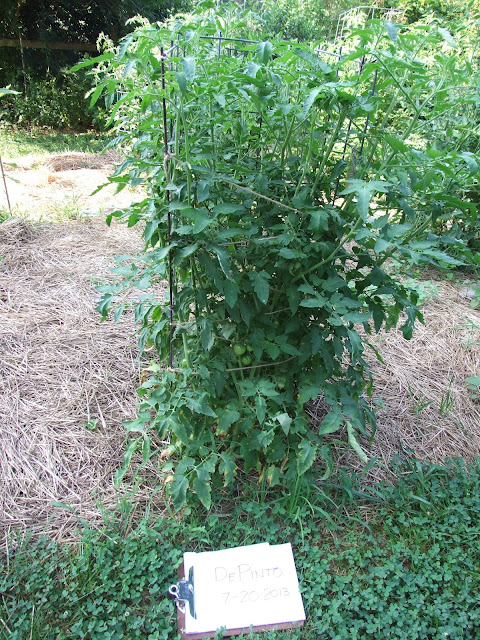'Mater Seeds
A travelogue, garden guide, and story of one librarian's obsession with the tomato
Tuesday, April 7, 2020
It's April 6, 2020: Checking In on Germinating Tomatoes
The first sixteen varieties are up! The ones we started on March 26 are already developing a second set of true leaves; I'm sold on the T5 growlights so far, even though I've always had very good results with inexpensive shop lights.
Most years I tend to focus on unusual varieties, especially those with an Appalachian background, no matter how temperamental or lackluster the yield as long as they taste good. This year, however, I need to focus on canning tomatoes to maintain my family's own food stores, so I've planted open-pollinated varieties with the yield and disease levels of many super-bred hybrids. I've also planted at least one landrace, Placero, a small, seedy, fat red tomato with great taste that hails from Mexico.
I admit I planted some of my heirlooms: Depp's Pink Firefly, Butler Skinner, Rose Beauty, Queen Aliquippa, Maruskin's Andes.
But I also planted two of the first heirlooms I ever got my hands on, thanks to Southern Exposure Seed Exchange in Mineral, Virginia, back in 1988: Heinz 1350 and Yellow Bell. Heinz 1350 is a red salad and canning tomato that throws 4-7 ounce fruits in clusters. Yellow Bell is a yellow paste tomato from east Tennessee that has no idea when to stop putting out sweet fat pear-shaped tomatoes a little bit bigger than a Roma.
This is the first year for Moneymaker, an English heirloom from 1913, and several others like Homestead 24. The latter is certainly eager to get started - both flats that I've started were the first to germinate, coming up in less than four days from seeding.
I'm trying two new paste tomatoes, San Marzano Short-Vine and Rio Grande, as well as a very short (but not dwarf) paste tomato called Martino's Roma, which was heavily productive and very good tasting fresh in salads when I first grew it a few years ago.
My big surprise this year? My husband John loves Jaune Flammee, one of the most beautiful and productive heirlooms of all time. It's a beautiful golden orb of a salad tomato that glows like the sunrise and tastes like heaven, and it's another heavy producer, throwing 3 to 7 salad-sized four-ounce fruits in tresses. Here's the surprise - I started seed I had saved back in 2012. Not in the freezer. Not in the fridge. In a paper packet in my office - and it looks like they'll all germinate. Now that's what I call a survivor...
Join me at the YouTube clip below for more information about what to do when your tomatoes germinate, how to water, and how to use chamomile tea to prevent fungal and bacterial diseases before they get started.
https://www.youtube.com/watch?v=qJ8WnInTXn0
Monday, April 6, 2020
2020 Victory Gardening in the Year of COVID-19

For several years I studied what are termed, by some "Defiant Gardens", or gardens that crop up everywhere in times of war. During the First World War, Charles Lathrop Pack designed the first comprehensive, nationwide plan for backyard gardeners to support the US's food supply. He published a book titled The War Garden Victorious, which was used during WWII to develop the War Garden into the Victory Garden.
In March of 2020 Victory Gardening burst forth with renewed vigor as Kentuckians were led by Governor Andy Beshear to stay #HealthyAtHome and practice extreme social distancing in order to stem the tide of COVID-19, a frightening and fast-moving viral infection capable of killing in a few days time.
Overnight, having workshops in a library setting became unthinkable. Gardeners are a friendly, open group - social distancing is a foreign concept unless there are only two of us and we're each working on the opposite end of a field. As the disease blazed toward Kentucky from several hard-hit areas, our library closed quickly, racing the spread of COVID, especially to our large high-risk population of library users over 50, or those with chronic diseases such as diabetes. And so our entire program of garden workshops were closed, vanished in an instant.
Nonetheless, we still need Victory Gardens right now. The Governor has charged us with maintaining our best health practices, including emotional and mental health. Gardening -- even tending to a few pots of herbs and flowers on the porch -- increases our exposure to healthful amounts of full-spectrum natural light and fresh air.
So we hope you'll join us in virtual gardening in the Year of COVID-19 - gardeners can't be kept apart for love nor money. Here's the first in our Clark County Public Library Victory Garden YouTube series. And of course, I'm starting with tomatoes....
https://www.youtube.com/watch?v=3QspjPysUCo
Monday, May 11, 2015
'Mater Sale: Monday, May 11, 2015
 |
| The tomatoes made the Fish hot peppers ride shotgun....this is the first year we've had peppers for sale, too. |
Monday, April 20, 2015
Germination and Transplanting 2015
So far Jennifer "Spoon" Mattern and I have transplanted about 500 tomatoes and peppers, including the following varieties:
'MATERS
Livingston's Beauty
Rose Beauty
Dwarf Purple Heart
Black Cherry
Butler Skinner
Depp's Pink Firefly
Placero
Jaune Flamee
Pike County Yellow
Andes Maruskin
St. Columbe
Giant Italian Paste, Gran Sasso Strain
Slavic Masterpiece
PEPPERS
Paradicsom Alaku
Fish
Syrian Three-Sided
Tunisian Baklouti
Starting April 10, we've transplanted all of them between then and April 17 - all of this set were sown on March 16, 2015, and most of them could have been transplanted on April 05.
I just sowed the following on April 18, so who knows if we'll have them up and hardened off by May 16 or not:
MATERS
Lena Mae Nolt's Holy Land
Yellow Cookie
Egg Yolk
Honeydrop
Sweet Adelaide (dwarf)
Olive Hill
Vorlon
Rosella Purple (dwarf)
Rebecca Sebastian's Bull Bag
Chocolate Pear
Old Virginia
Yellow Oxheart
PEPPERS
Puppenpepper (my seed, probably a cross of Fish and Matchbox, from 2013)
Jimmy Nardello (fresh)
Joelene's Red (fresh)
Peter Pepper (very old seed)
Matchbox (Fedco seed, older)
Hinkelhatz (older seed)
'MATERS
Livingston's Beauty
Rose Beauty
Dwarf Purple Heart
Black Cherry
Butler Skinner
Depp's Pink Firefly
Placero
Jaune Flamee
Pike County Yellow
Andes Maruskin
St. Columbe
Giant Italian Paste, Gran Sasso Strain
Slavic Masterpiece
PEPPERS
Paradicsom Alaku
Fish
Syrian Three-Sided
Tunisian Baklouti
Starting April 10, we've transplanted all of them between then and April 17 - all of this set were sown on March 16, 2015, and most of them could have been transplanted on April 05.
I just sowed the following on April 18, so who knows if we'll have them up and hardened off by May 16 or not:
MATERS
Lena Mae Nolt's Holy Land
Yellow Cookie
Egg Yolk
Honeydrop
Sweet Adelaide (dwarf)
Olive Hill
Vorlon
Rosella Purple (dwarf)
Rebecca Sebastian's Bull Bag
Chocolate Pear
Old Virginia
Yellow Oxheart
PEPPERS
Puppenpepper (my seed, probably a cross of Fish and Matchbox, from 2013)
Jimmy Nardello (fresh)
Joelene's Red (fresh)
Peter Pepper (very old seed)
Matchbox (Fedco seed, older)
Hinkelhatz (older seed)
Wednesday, July 24, 2013
Late July 'Mater Update
 |
| The Andes in the 'Mater Patch again. Plenty of flowers - she's just not interested in setting any fruit. The 'Mater Patch plants were almost all planted in 2nd quarter Sagittarius. |
 |
| Bull Bags on the vine. I believe these will top out between one and two pounds apiece this year due to all the rain. |
 |
| Butler finally looking like a proper tomato plant and thinking about producing fruit. Bless Butler Skinner's little heart, he's slow but worth the wait. |
 |
| Chapman looking just pretty and problem free. |
 |
| Costoluto Genovese being huge and productive. There are easily twenty fruit already on this one plant, and they will all probably top 8 ounces from the look of it. |
 |
| Cuneo Giant Pear - which may be the same tomato, according to Dr. Carolyn Male, as Coeur d'Albenga, Piriform, and possibly Liguria. From Tatiana Kouchnareva in British Columbia. |
 |
| Doing very well - took a while to set fruit, but Emerald Evergreen is throwing them right and left now that she's decided to do it. |
 |
| Jaune Flammee isn't a tomato orphan, but she is a mainstay of our garden - every year without fail. |
Sunday, July 21, 2013
June & July Tomato Comparisons
Our first nearly-ripe tomatoes made themselves apparent yesterday: Black Cherry and Peacevine Cherry, one fruit each. But while waiting for them to ripen, here are the other comparison pictures for the 2013 grow-out varieties. All of these pictures were taken a month ago.
 |
| Maruskin's Andes up in the new Front Farm beds. |
 |
| Second Andes in the new Front Farm beds. |
 |
| Third of three Andes: this one is planted in the Mater Patch out back. |
 |
| Livingston's Beauty in the Mater Patch. |
 |
| Younger Livingston's Beauty in the Front Farm beds. |
 |
| Black Cherry's first truss of fruit. |
 |
| A monster of a plant - quite healthy in all respects - and keen on producing tons of beautifully fluted fruits. Can't wait to taste the tomatoes. It's been a joy to grow out so far. |
 |
| Cuneo Paste aka Liguria was planted to replace a Christopher Columbus that was broken by an animal intruder. |
 |
| Can't wait to try DePinto - I believe that DePinto was the first to set fruit this year. |
 |
| Two baby Ernie's Plump sharing the beet and sorrel bed together. A favorite variety from Marianne Jones. |
 |
| Nobody's growing this variety in Seed Savers the last few years - figured I needed to keep it going. It's a great variety, and very trustworthy with production and quality. |
 |
| A standby - these are planted in the old Kitchen Garden just off the porch. |
 |
| Kenosha Paste is much acclaimed among the tomato-growing Seed Savers with similar taste. |
 |
| I wish I had enough property to grow a dozen of these beautiful Lena Mae Nolt's Holy Land oxhearts! |
 |
| Via Dr. Carolyn Male. Not remotely like Roma - but a Roma-sized fresh-eating paste from an Italian family. |
 |
| Peacevine Cherry will eventually fill this extra-tall cattle panel cage. . |
 |
| Prue takes the prize for stringiest, most pitiful looking plant - and this is a well-grown specimen! But the fruit are a real treat, in spite of the Addams Family demeanor of the plant. |
 |
| A keeper from Estill County. Named for the Rose family on Happy Top Road. |
 |
| One of Craig LeHoullier's Cross-Hemisphere Dwarf Tomato Project varieties. No cage required so far. |
 |
| Another dwarf from the breeding project. |
 |
| Supposed to be heat resistant and extremely productive. We'll see. I just hope it tastes good. Introduced from Greece by Glecklers in the 1950s. |
 |
| The Mater Patch. |
 |
| Growing Yellow Cookie instead of Verna Orange this year; I miss Verna Orange, but I was out of seed this year and didn't have time to order before planting. |
Subscribe to:
Comments (Atom)
































